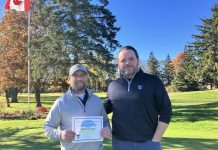
Multidisciplinary creator and storyteller Sandra Lamouche combines contemporary dance and Cree tradition in Out of Wounds, an Indigenous dance performance making its world premiere during Public Energy Performing Arts’ 2024-25 season.
Lamouche will perform her new work at Nozhem First People Performance Space at Trent University’s Gzowski College building at 7 p.m. on Friday, November 1st and Saturday, November 2nd. Tickets are priced on a pay-what-you-can sliding scale starting at $5.
A member of the Bigstone Cree Nation in northern Alberta and now residing in Blackfoot territory, Lamouche has spent her career crafting Indigenous dances that draw on traditional dance and tie together land-based practices with healing, social, and ecological justice. Also a champion hoop dancer, her work explores teachings around healing, the beautiful struggle of life, and overcoming its challenges.
Out of Wounds is inspired by Lamouche’s own trauma and her healing experience with a sacred fungus that grows on willow trees.
“Out of Wounds is born from the sensory experience of dealing with racial trauma and anxiety,” Lamouche says in a media release. “During a time of heightened anxiety, I started craving the scent of wagimauskigan, the diamond willow fungus. My mother and her father, Nimosom, my grandfather, used to burn the fungus for smudge and prayer and I found that it calmed me when I meditated.”
The fungus, which is found on several species of willow trees, causes the tree to grow around the fungus, creating diamond-shaped deformations of alternating colours in the wood, which is prized by willow carvers and furniture makers. The fungus itself is a sacred medicine for Indigenous peoples and has also been used for necklaces and ornaments in clothing.

In the release, Lamouche outlines how carrying wagimauskigan around sparked her curiosity about its meanings and traditional uses. Upon doing research, she learned how the fungus was used by the Cree people.
“Cree women carved the fungus, fashioned beads for necklaces from it for spiritual protection — sometimes they even made necklaces for the horses,” she says. “I found photos of Cree men clad in robes (blankets) with the fungus sewn into the shoulders. Discovering that Cree people had worn it at one time, like I had been doing, I felt like a blood memory had been activated.”
In a blog post about international trauma and blood memory for Defining Moments Canada, Lamouche describes how she unsuccesfully tried to carve the fungus into beads. When she reached out to friends and family, she found out none of them had seen or heard of the practice, the necklaces, or the robes. The use of the fungus seemed to be a forgotten practice.
“As I continued to read and learn more about the wagimauskigan, I discovered that the fungus grows out of the wounds of trees,” Lamouche writes. “This discovery shocked me because this medicine ‘spoke’ to me while I was feeling wounded myself.”
“I was like that broken tree that had grown medicine out of wounds. My learning and experience with wagimauskigan and using it for healing literally came from my own wounds of anxiety and trauma.”
According to Lamouche, she felt compelled to use movement to explore the concept of growing out of wounds, giving rise to Out of Wounds.

Lamouche’s dance creations are informed by her more than three decades of collaboration with numerous Indigenous dance companies across Turtle Island in different styles.
In 2021, she obtained her M.A. with a focus on hoop dance and healing from Trent University, having successfully defended her thesis which examines Indigenous dance as a social determinant of health and well-being. She is also a two-time TEDx Speaker and the author of books including the award-winning children’s book We Belong to the Drum.
To learn more about Out of Wounds and to purchase advance tickets, visit www.publicenergy.ca/performance/out-of-wounds-sandra-lamouche/.
kawarthaNOW is proud to be a long-time media sponsor of Public Energy Performing Arts.


























